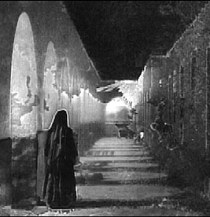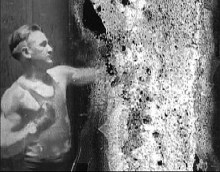Decasia

USA, 2002. Not Rated. 70 minutes.
Writer: Bill Morrison
Music: Michael Gordon
Slide Designer: Laurie Olinder
Producer: Bill Morrison
Director: Bill Morrison
|
Decasia |
||
 |
USA, 2002. Not Rated. 70 minutes.
Writer: Bill Morrison |
|
| Grade: C | Review by Jeff Vorndam |
![]() ccording
to the National
Film Preservation Federation, half of the films made in the U.S. before
1950 are no longer extant. Film itself consists of a clear plastic base, a thin
layer of gelatin emulsion, and an image composed of either color dyes or particles
of silver. It is highly susceptible to decay. Pre-1950 films have highly flammable
nitrate bases that give off an acidic gas as they degrade, leaving the film
itself tarnished and rusty, with splotches on the image.
ccording
to the National
Film Preservation Federation, half of the films made in the U.S. before
1950 are no longer extant. Film itself consists of a clear plastic base, a thin
layer of gelatin emulsion, and an image composed of either color dyes or particles
of silver. It is highly susceptible to decay. Pre-1950 films have highly flammable
nitrate bases that give off an acidic gas as they degrade, leaving the film
itself tarnished and rusty, with splotches on the image.
Bill Morrison has made a feature film culled from decayed film stock. It's titled Decasia, a name that suggests a symphony of decay. Indeed, the film premiered in Switzerland as part of a multimedia stage show that included a 55-piece orchestra. Taken out of the multimedia presentation (where it was merely the visual component of a larger ensemble) and made the center of attention, Decasia suffers as a viewing experience. There is simply not enough of interest onscreen to sustain its seventy-minute running time.
While film restorers work hard to rescue decaying film stock and remove scratches
and spots from the image, Morrison purposely uses these dying prints to explore
the theme of mortality--both film's and man's. The footage depicts people creating
art and technology and practicing religion, all of which can be seen as attempts
to overcome mortality. Many of the scenes are from travelogues, newsreels, or
old silent films (one of which appears to be The Last Egyptian, a 1914
film based on the L. Frank Baum book).  The
athlete who achieves physical perfection and wins lasting fame, the painter
who leaves behind a masterpiece, the explorer who makes a new discovery--all
are contributors to history, as is the filmmaker who documents the life around
him. By viewing a film that is blotchy and streaked, we are made conscious of
our own mortality. Decasia depicts life as a constant struggle against
oblivion, and in our actions we are defined, both tragically and heroically.
The
athlete who achieves physical perfection and wins lasting fame, the painter
who leaves behind a masterpiece, the explorer who makes a new discovery--all
are contributors to history, as is the filmmaker who documents the life around
him. By viewing a film that is blotchy and streaked, we are made conscious of
our own mortality. Decasia depicts life as a constant struggle against
oblivion, and in our actions we are defined, both tragically and heroically.
This probably isn't a novel idea for a film (I feel like I've seen this done before, if not by Stan Brakhage then by someone else who was fond of scraping film emulsion), but it occasionally produces wondrous images. One of the more poetic images in the film is of a boxer who occupies the unscathed side of the frame. He punches relentlessly into the oblivion--the scratchy, deformed decay spot that takes up the other side of the frame. Another shot is a long one of a man climbing a towering ladder as the plasma cell splotches and scribbles undulate below him. The living and dead co-exist in some scenes where the blob-patches look like ghosts who shadow the people in the frame. Unfortunately, the idea wears thin after just a few minutes, and there are long stretches that seem to repeat themselves.
It doesn't help that the musical score accompanying the film (or, perhaps it's more accurate to say the film accompanies the score, as I believe that was the intention) borders on annoying. It is a constant sound, somewhere between a wail and a drone, that does the job of providing a contrast to the image, but fails to evoke the hypnotic state it strives for. Often, the music creepifies the images, as when a shot of nuns ushering a line of marching schoolgirls comes across like a death sentence, or when the crying at a baptism seems like an expression of terrible pain. In other instances though, the music crescendos to no discernable onscreen action. As a mood setter, it conveys dread, but little else.
Decasia is a tough sit if you're not used to avant-garde films, and even a film-school hardened veteran like myself empathized with the man behind me, who got up from his seat about halfway though and grumbled, "There's only so much of this I can take."
Decasia played at the 45th San Francisco International Film Festival on April 21 and April 24, 2002.
Review
© April 2002 by AboutFilm.Com and the author.
Images © 2002 The Ridge Theater. All Rights Reserved.
| |
||
| |
||
| |
||
| |
||
| |